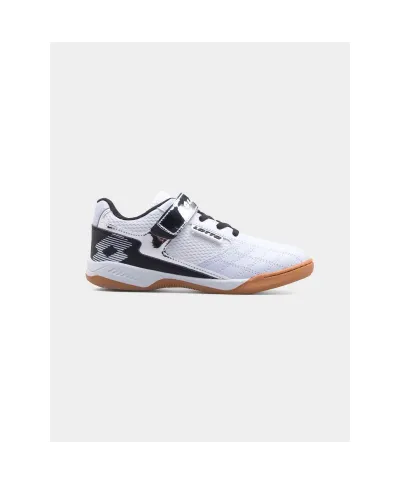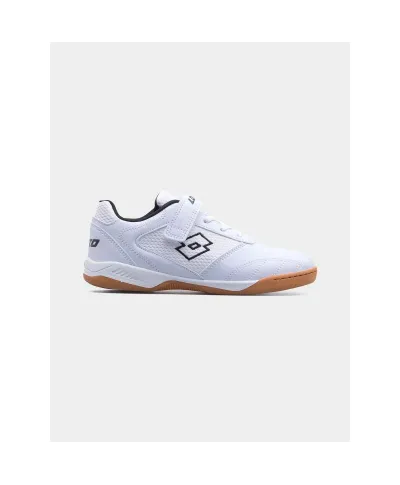Why is choosing the right indoor shoes so important?
Indoor football, or futsal, differs from traditional outdoor play primarily in the surface and pace of play. Indoor sports require quick reactions, agility and precise ball control. On the hard, smooth surface of the hall, regular shoes for playing football on grass may prove completely unsuitable. Indoor shoes, or special shoes designed for playing indoors, provide not only excellent grip, but also comfort of use, cushioning and foot protection.
Poorly selected shoes can not only make the game difficult, but also lead to injuries. That is why it is so important to spend time choosing the right footwear, adapted to your style of play, preferences and foot structure.
What are the characteristics of indoor shoes?
Indoor shoes are specialist shoes for indoor football, which differ from classic football shoes for grass pitches in many respects. First of all, they have a flat sole made of rubber or another material that guarantees good grip on a smooth surface, such as parquet or synthetic surfaces.
Here are some key features to look for when choosing indoor shoes:
1. Anti-slip sole
The sole in indoor shoes is designed to provide excellent grip on hard surfaces. It should be made of rubber that does not leave marks on the parquet, which is important in most sports halls. This minimizes the risk of slipping during quick turns or sudden changes of direction.
2. Cushioning
Indoor football is a dynamic sport in which the feet are exposed to numerous shocks. Good cushioning in shoes reduces the load on joints and tendons, which is especially important during longer training sessions or frequent playing. It is worth paying attention to the presence of appropriate cushioning systems in the sole, which absorb energy during running and jumping.
3. Durability and lightness
Indoor football shoes must be durable and lightweight at the same time. Thanks to this, they allow for dynamic movement on the pitch, without feeling the strain on your legs. It is important that the material they are made of is durable and resistant to abrasion, which will extend their life, even with intensive use.
4. Foot stability and support
Good indoor shoes should provide foot stability, especially with sudden turns or sudden movements. Shoes with an appropriate heel construction and arch support minimize the risk of injuries such as ankle sprains. Look for shoes that offer a good fit and additional reinforcements in strategic places.
How to choose the right shoe size?
Choosing the right size of indoor football shoes is a key aspect that affects the comfort of the game. Shoes that are too big can cause the foot to shift, which not only reduces ball control, but also increases the risk of abrasions and blisters. On the other hand, shoes that are too small can press on the foot, leading to pain and even more serious injuries.
To choose the right size:
Measure your foot - it is best to do this in the evening, when your feet are naturally slightly larger after a full day of activity. Pay attention to the length and width of your foot.
Check the size chart - each brand may have slightly different sizes, so it's worth checking what measurements correspond to each size.
Try on your shoes - if you can, it's always worth trying on shoes before buying. Make sure you have some room for your toes, but the shoes fit your foot well.
Which indoor shoes should you choose for different styles of play?
Choosing indoor shoes may also depend on your style of play. Indoor football requires different skills, and the right shoes can support a specific way of moving around the pitch.
1. For fast and agile players
If you rely on fast pace, agility and dynamic changes of direction, choose lightweight indoor shoes with a thin sole that provide maximum grip. Good stability and foothold are key to not losing your balance during fast movements.
2. For technical players
If you value ball control and precise passes, look for indoor shoes with a soft upper that provides a better feel for the ball. These types of shoes are usually made of flexible materials that allow for a better fit and better ball control.
3. For goalkeepers
Goalkeepers need shoes that provide both stability and protection. A reinforced upper and good cushioning will be key for goalkeepers who often have to make rapid throws and jumps.
How to care for indoor shoes?
To ensure that your indoor football shoes last for a long time, it is worth taking care of them properly. Here are some tips to extend the life of your indoor shoes:
Clean your shoes regularly - after each match or training session, remove dirt from the soles and uppers. You can do this with a damp cloth or a soft brush.
Avoid moisture – indoor football boots are not designed for wet conditions, so don’t play in them on a wet surface. Leave your boots in a dry and airy place after the game.
Store your boots properly – don’t leave your indoor boots in too high temperatures or in direct sunlight. Also, avoid storing them in a backpack or sports bag for long periods of time to avoid excessive moisture.
Summary
Choosing the right indoor football boots has a huge impact on the quality of your game and comfort. Pay attention to things like grip, cushioning, lightness and stability, as well as choosing the right size. Remember that your indoor boots should be adapted to your style of play to help you achieve the best results on the pitch.
Don’t forget to regularly care for your boots so that they last a long time and are always in the best condition. Playing indoor football is a dynamic and demanding discipline, so it’s worth investing in good indoor boots that will provide you with comfort, protection and excellent performance on the court.












